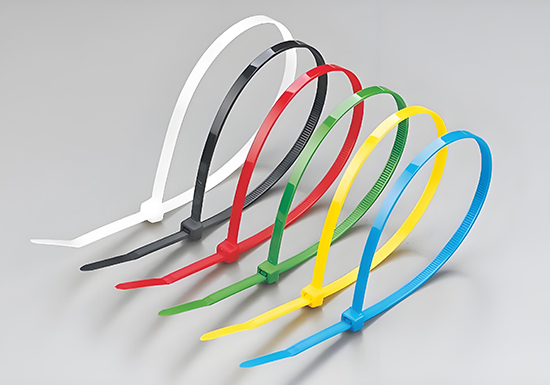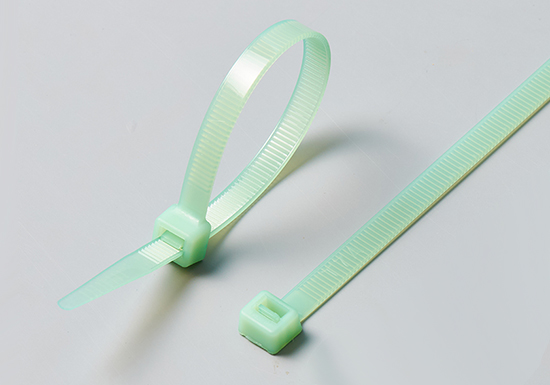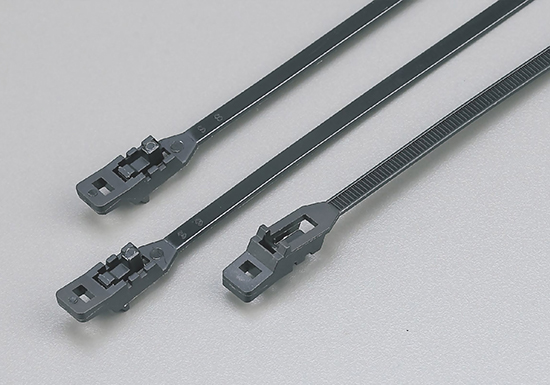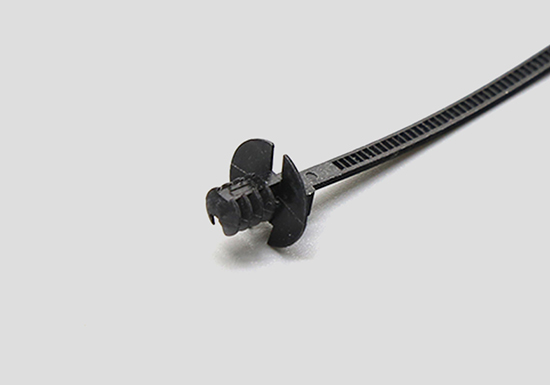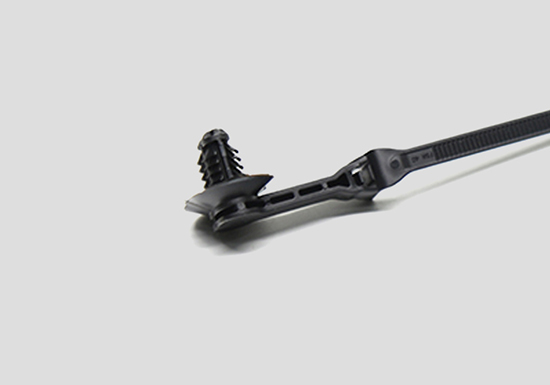The company provides PA66 low-temperature resistant cable tie material
2025-07-24 09:46:58 View:376
PA66 low-temperature resistant cable tie material, as a high-performance engineering plastic, demonstrates unique advantages in industrial applications. This material is based on nylon 66 (PA66) and has undergone a special modification process to enhance its mechanical properties and durability in low-temperature environments, making it an ideal choice for fields such as cold chain logistics, outdoor equipment, and automotive parts. The following will conduct a comprehensive analysis from aspects such as material properties, application scenarios, market status quo, and purchasing suggestions.
 I. Material Properties and Technological Innovation
I. Material Properties and Technological Innovation
The core advantage of PA66 low-temperature resistant cable tie material lies in the stability of its molecular structure. Ordinary nylon materials will become brittle at temperatures below -20℃, while modified PA66 low-temperature resistant materials can withstand extreme environments ranging from -40℃ to -50℃. The tensile strength of high-quality PA66 low-temperature resistant material can still maintain above 80MPa in low-temperature environments, and the elongation at break exceeds 30%, which is much higher than that of ordinary nylon materials. This performance improvement mainly relies on three technologies:
Copolymerization modification technology: Improving low-temperature toughness by introducing flexible chain segments
2. Nanocomposite technology: Adding layered silicates enhances impact resistance
3. Plasticizer optimization: Special low-temperature plasticizers are used to lower the glass transition temperature
The company's modified PA66 low-temperature resistant material can still maintain over 90% of its initial strength after 500 cold and hot cycles at -45℃. This durability makes it particularly suitable for use in extremely cold regions.
Ii. Analysis of Typical Application Scenarios
1. Cold chain logistics system: In scenarios such as refrigerated trucks and cold storage facilities, traditional cable ties are prone to cracking, leading to the failure of goods fixation. After adopting PA66 low-temperature resistant cable ties, it can ensure the structural stability throughout the entire process from a -30℃ freezing environment to normal temperature loading and unloading. The actual measurement data of a certain logistics equipment manufacturer shows that after switching to low-temperature resistant cable ties, the packaging damage rate during transportation decreased by 72%.
2. Automotive industry: The battery packs of new energy vehicles need to withstand a sharp temperature difference ranging from -40℃ (in northern winter) to 85℃ (battery operating temperature) for fixation. After the battery pack of a certain brand of electric vehicle adopted PA66 low-temperature resistant cable tie material, it passed the 1500-time temperature shock test stipulated in the SAE J2380 standard without failure.
3. Outdoor engineering: The fixed requirements for outdoor equipment such as power facilities and communication base stations in extremely cold regions. The cable ties made of this material for a certain high-altitude base station have shown no signs of aging after continuous use for five years at an altitude of 4,500 meters and with an average annual temperature of -5℃.
Iii. Market Status Quo and Supply Chain Insights
The current PA66 low-temperature resistant cable tie material market shows a hierarchical supply pattern. The price range of domestic modified materials is 28 to 45 yuan per kilogram, while the prices of imported brands such as BASF and DuPont reach 60 to 90 yuan per kilogram. It is worth noting that through technological innovation, the company has been able to offer alternative solutions with performance close to imported products but at a 30% lower price.
There are three obvious trends in the industry:
- Alternatives to environmentally friendly plasticizers: The EU REACH regulation promotes the development of phthalate-free formulations
- Color marking system: Different temperature grades are visually distinguished by adding color masterbatches
- Application of recycled materials: Some manufacturers blend 30% recycled materials with virgin materials, which not only maintains performance but also reduces the carbon footprint
Iv. Purchase and Usage Guide
1. Key indicator verification: Require suppliers to provide:
- ASTM D638 standard Low Temperature Tensile Test Report
UL94 Flame Retardant Grade Certificate (V2 grade or above is preferred)
- Cold and hot cycle test data (at least 200 cycles)
2. Processing technology compatibility
The injection molding temperature is recommended to be controlled between 260 and 280 degrees Celsius
The mold design should take into account a shrinkage rate of 3‰ to 5‰
For transparent or light-colored products, anti-yellowing formulas should be selected
3. Cost Optimization Plan
Bulk purchases (over 5 tons) can enjoy a discount of 15% to 20%
- Mix and use products of different temperature grades (-50℃ grade for core parts and -30℃ grade for non-critical parts)
Pay attention to the comprehensive cost including tax and transportation. Some suppliers in East China offer factory price services
V. Future Technological Development Directions
Industry experts predict that the next-generation PA66 low-temperature resistant material will break through in three dimensions:
1. Self-repairing function: Autonomous repair of tiny cracks is achieved through microcapsule technology
2. Intelligent temperature sensing: Fault early warning is achieved as the material resistance changes with temperature
3. Bio-based PA66: Monomers synthesized from renewable resources such as castor oil
Tests conducted by a certain research institute have shown that the graphene-reinforced PA66 low-temperature resistant material in the experimental stage has demonstrated excellent performance at -70℃ and is expected to enter the commercialization stage in 2026. This material may rewrite the fixation solutions for polar equipment. From the above analysis, it can be seen that the technical maturity of PA66 low-temperature resistant cable tie material and market demand have formed a virtuous cycle. When making a purchase, users need to make a comprehensive consideration based on the specific application environment, cost budget and certification requirements, and at the same time pay attention to the performance improvement opportunities brought by the technological iteration of the industry. For special working conditions, it is recommended to jointly conduct application tests with material suppliers to fully unleash the performance potential of this engineering plastic.
From the above analysis, it can be seen that the technical maturity of PA66 low-temperature resistant cable tie material and market demand have formed a virtuous cycle. When making a purchase, users need to make a comprehensive consideration based on the specific application environment, cost budget and certification requirements, and at the same time pay attention to the performance improvement opportunities brought by the technological iteration of the industry. For special working conditions, it is recommended to jointly conduct application tests with material suppliers to fully unleash the performance potential of this engineering plastic.

The core advantage of PA66 low-temperature resistant cable tie material lies in the stability of its molecular structure. Ordinary nylon materials will become brittle at temperatures below -20℃, while modified PA66 low-temperature resistant materials can withstand extreme environments ranging from -40℃ to -50℃. The tensile strength of high-quality PA66 low-temperature resistant material can still maintain above 80MPa in low-temperature environments, and the elongation at break exceeds 30%, which is much higher than that of ordinary nylon materials. This performance improvement mainly relies on three technologies:
Copolymerization modification technology: Improving low-temperature toughness by introducing flexible chain segments
2. Nanocomposite technology: Adding layered silicates enhances impact resistance
3. Plasticizer optimization: Special low-temperature plasticizers are used to lower the glass transition temperature
The company's modified PA66 low-temperature resistant material can still maintain over 90% of its initial strength after 500 cold and hot cycles at -45℃. This durability makes it particularly suitable for use in extremely cold regions.
Ii. Analysis of Typical Application Scenarios
1. Cold chain logistics system: In scenarios such as refrigerated trucks and cold storage facilities, traditional cable ties are prone to cracking, leading to the failure of goods fixation. After adopting PA66 low-temperature resistant cable ties, it can ensure the structural stability throughout the entire process from a -30℃ freezing environment to normal temperature loading and unloading. The actual measurement data of a certain logistics equipment manufacturer shows that after switching to low-temperature resistant cable ties, the packaging damage rate during transportation decreased by 72%.
2. Automotive industry: The battery packs of new energy vehicles need to withstand a sharp temperature difference ranging from -40℃ (in northern winter) to 85℃ (battery operating temperature) for fixation. After the battery pack of a certain brand of electric vehicle adopted PA66 low-temperature resistant cable tie material, it passed the 1500-time temperature shock test stipulated in the SAE J2380 standard without failure.
3. Outdoor engineering: The fixed requirements for outdoor equipment such as power facilities and communication base stations in extremely cold regions. The cable ties made of this material for a certain high-altitude base station have shown no signs of aging after continuous use for five years at an altitude of 4,500 meters and with an average annual temperature of -5℃.
Iii. Market Status Quo and Supply Chain Insights
The current PA66 low-temperature resistant cable tie material market shows a hierarchical supply pattern. The price range of domestic modified materials is 28 to 45 yuan per kilogram, while the prices of imported brands such as BASF and DuPont reach 60 to 90 yuan per kilogram. It is worth noting that through technological innovation, the company has been able to offer alternative solutions with performance close to imported products but at a 30% lower price.
There are three obvious trends in the industry:
- Alternatives to environmentally friendly plasticizers: The EU REACH regulation promotes the development of phthalate-free formulations
- Color marking system: Different temperature grades are visually distinguished by adding color masterbatches
- Application of recycled materials: Some manufacturers blend 30% recycled materials with virgin materials, which not only maintains performance but also reduces the carbon footprint
Iv. Purchase and Usage Guide
1. Key indicator verification: Require suppliers to provide:
- ASTM D638 standard Low Temperature Tensile Test Report
UL94 Flame Retardant Grade Certificate (V2 grade or above is preferred)
- Cold and hot cycle test data (at least 200 cycles)
2. Processing technology compatibility
The injection molding temperature is recommended to be controlled between 260 and 280 degrees Celsius
The mold design should take into account a shrinkage rate of 3‰ to 5‰
For transparent or light-colored products, anti-yellowing formulas should be selected
3. Cost Optimization Plan
Bulk purchases (over 5 tons) can enjoy a discount of 15% to 20%
- Mix and use products of different temperature grades (-50℃ grade for core parts and -30℃ grade for non-critical parts)
Pay attention to the comprehensive cost including tax and transportation. Some suppliers in East China offer factory price services
V. Future Technological Development Directions
Industry experts predict that the next-generation PA66 low-temperature resistant material will break through in three dimensions:
1. Self-repairing function: Autonomous repair of tiny cracks is achieved through microcapsule technology
2. Intelligent temperature sensing: Fault early warning is achieved as the material resistance changes with temperature
3. Bio-based PA66: Monomers synthesized from renewable resources such as castor oil
Tests conducted by a certain research institute have shown that the graphene-reinforced PA66 low-temperature resistant material in the experimental stage has demonstrated excellent performance at -70℃ and is expected to enter the commercialization stage in 2026. This material may rewrite the fixation solutions for polar equipment.


